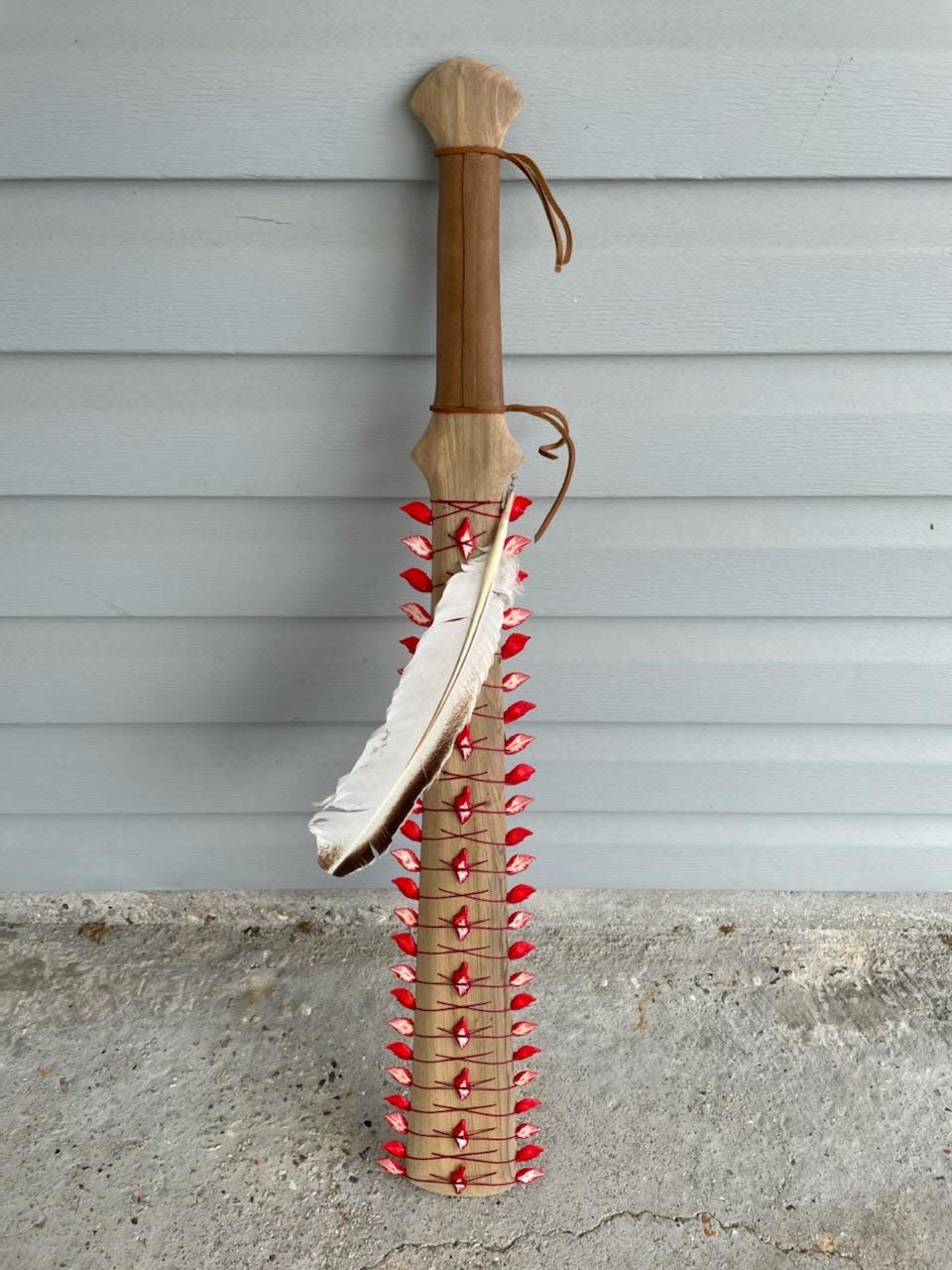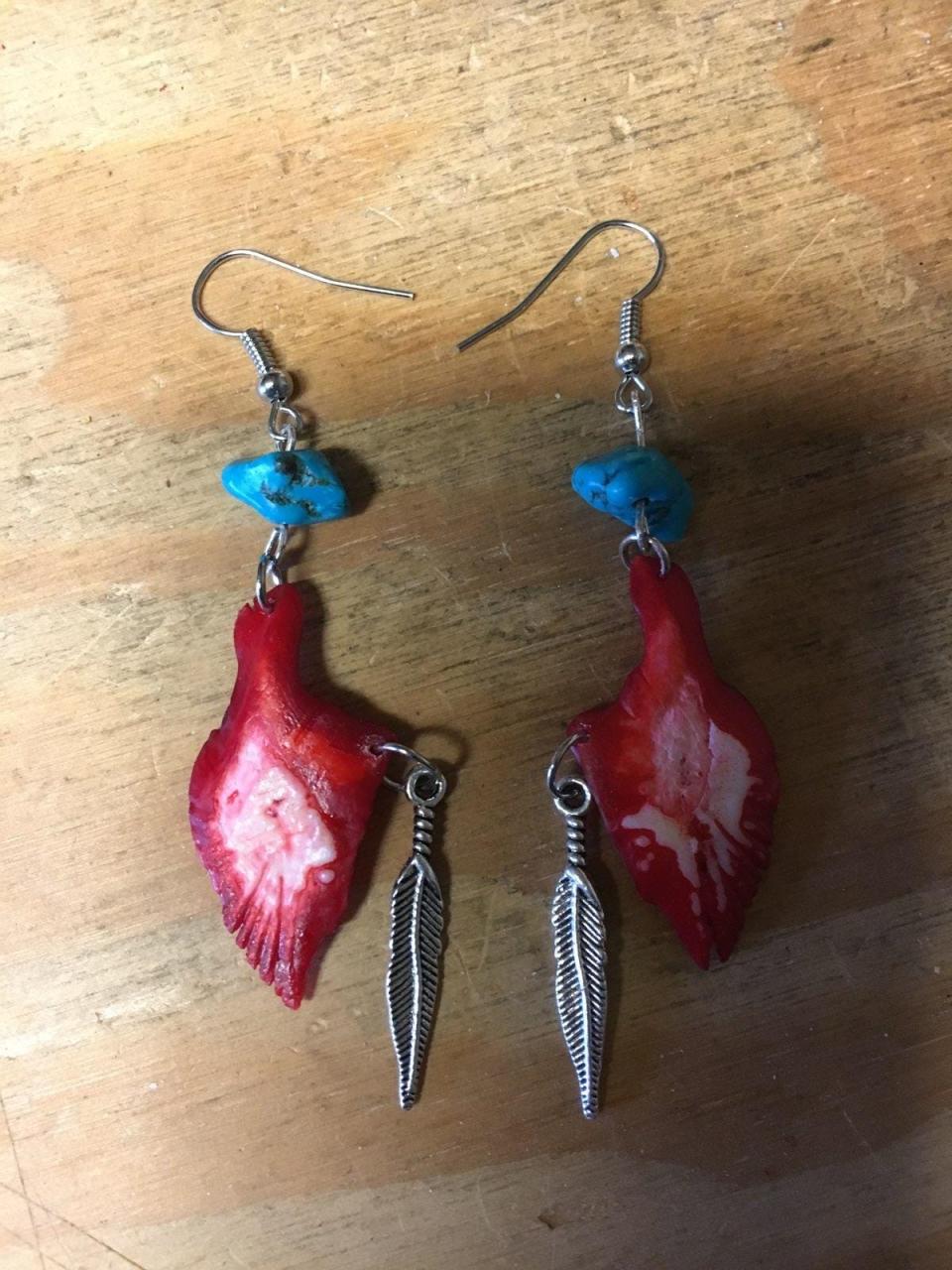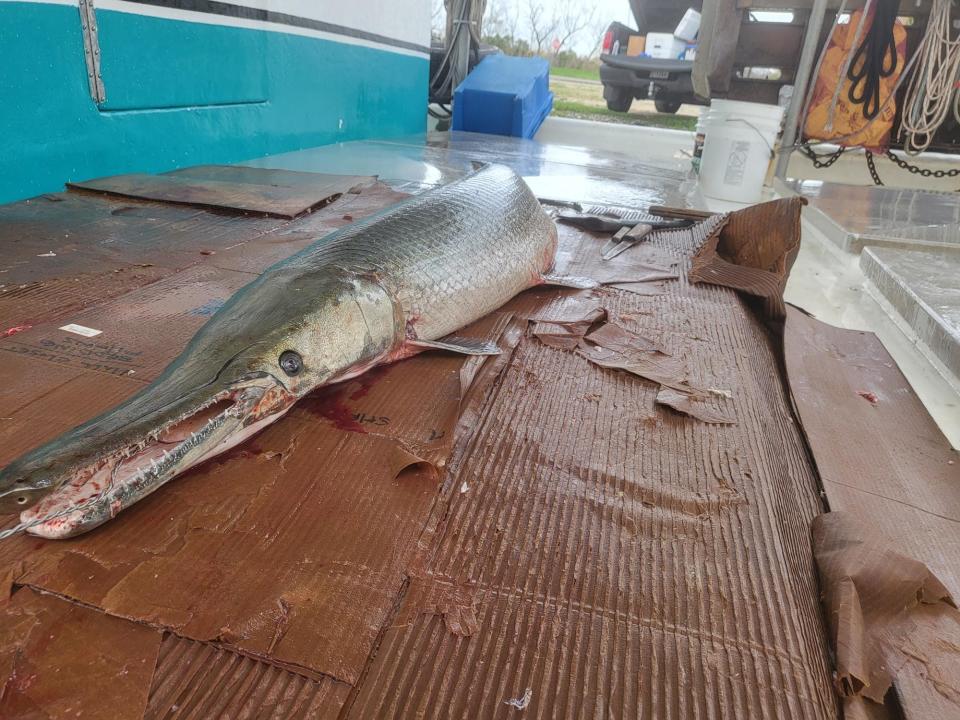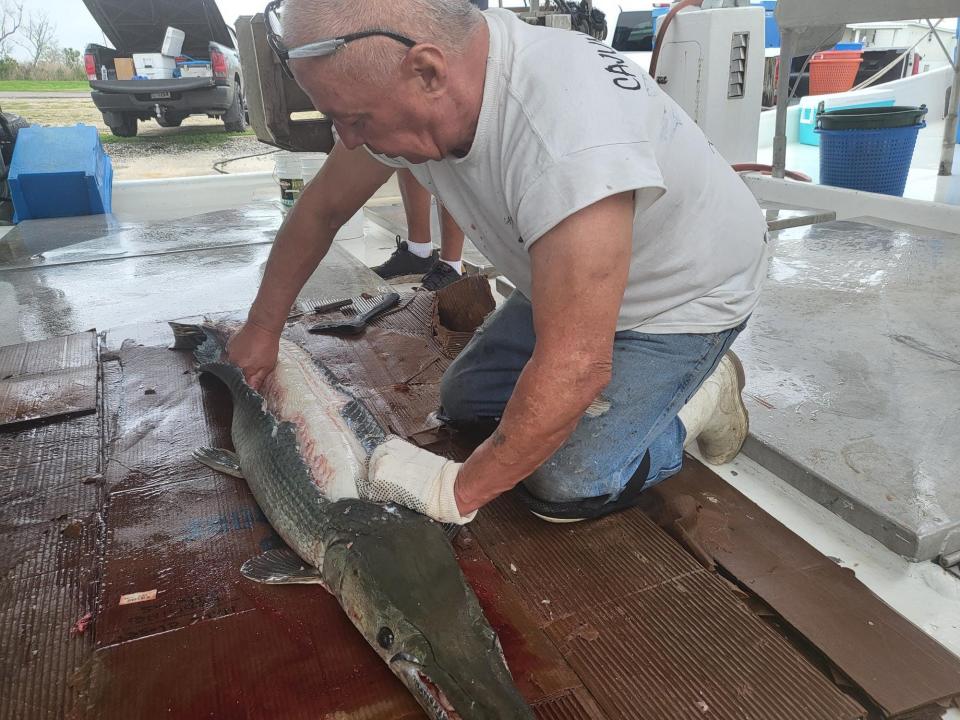Fishermen, artists, Houma Nation carry on traditions of 'living fossil' in Dulac
Hatchet and machete cut through teeth and bone before Terry Parfait's filet knife attacks the viscera of a 60-pound living "dinosaur."
"Boy, I do a number on these," he said.
For centuries, Houma natives have utilized gar - one of earth's oldest surviving jawed vertebrates - for food, weapons and ornamentation. Keeping the tradition alive, native people say, is a sacred responsibility.
Parfait kneels on the deck of a shrimp boat in Dulac as he hacks off the back flesh with his machete first. Stevie Ray Vaughan's "Pride and Joy" plays on a small stereo from the cabin of the boat. The guitar riff squeals as the his blades cut deep into the fish.
Parfait is working against the clock. He said the fish has to be gutted while it's still alive to avoid the meat going bad. If the fish is allowed to die, or the meat gets wet, it becomes like mashed potatoes.
"It's not like other fish. These fish are prehistoric," he said.

After the back is removed, the sides are splayed out, to remove the organs. Parfait is careful not to pop the egg sacks. Roe is prized in many fish, but gar eggs are poisonous to mammals. Finally, the hatchet chops chunks of the flesh into steaks.
This gar was caught with a large Styrofoam bobber fashioned with a metal cord that ends in a large metal hook. The hook is baited with a fish head. Once the gar bites down, it cannot get away. The bobber keeps it close to the surface.
The gar is a carry-over from the Jurassic Period, with a collection of evolutionary tools that have kept it relatively unchanged for millions of years. One of those tools is its incredibly tough scales. One thing Mother Nature couldn't have predicted was those scales becoming jewelry.
Parfait is fileting the fish for its meat, but Douglas P. Fazzio is standing close by to collect the skin and scales. He boils the flesh to separate the two, then bleaches the scales to remove any stench. From there, he dyes them to add color and turns them into jewelry ‒ earrings, necklaces, and more.

Fazzio was an offshore worker, but a crane fell on him when he was 24 and left him unable to work. He took up woodworking to stay busy. Five years ago he saw someone making jewelry out of the fish, and he decided to try his hand at it. Last year, he began combining the two interests, making warclubs styled after those of the Maori people. He carves the wood into a club shape, and fashions the gar scales on the side for a saw-styled blade.
"I always like a challenge, so I always wanna make something different all the time," Fazzio said. "So I started making the war clubs."

A resource
The war club may be fashioned after the Hawaiian indigenous people, but south Louisiana's indigenous groups also fashioned their tools from the gar. The scales are perfectly shaped for arrowheads, explained Janie Verret Luster. Luster and Fazzio are members of the United Houma Nation.
"There are many uses for them… in the head of the gar there's a bone that can actually be used to put on a spear point," she said. The skull is dried, and then the bone is tapped loose, "It actually, the bone, looks like an eagle coming down in flight."
The spear point goes in easily, but catches if you try to retract it because of a file-like texture on the top.
The gar wasn't only used for tools, it was an important food source of the Houma people. Luster said that the fish was a staple. It was smoked into something called "tasso." Luster did a show with Chef John Folse teaching the technique.
"They would actually get the meat, and slice it into strips, salted down - that was our way of preserving back in those days - and then they would hang it on a clothesline or over a fire and smoke it," Luster said.
Fazzio learned the jewelry from seeing Luster's work. Luster learned the art from her mother, who would use the scales to craft a flower. She would use clay from the bayou known as "terre gras" to glue the scales together.
"She used to make flowers out of them before the day of the glue gun," Luster said. "She would take the blue clay from the bayou side and make flowers and use a twig as a branch."

What makes the fish and its scales so special?
The scales are made from an enamel substance, and they grow out in a layering similar to plate male. Enamel is the substance human teeth are made from. These ganoid scales earned the fish the Cajun French name Le Poisson Arme' ‒ the armored fish.
Biologist Solomon David specializes in studying gar. He said it's estimated that the gar family has existed for about 157 million years, and the alligator gar has existed relatively unchanged for 2.5 million to 5 million years. That would mean the gar outlasted the king of the dinosaurs, the Tyrannosaurus Rex.
Gars can be found living from southern Canada all the way to Costa Rica. It remains a dominant predator in all its habitats. Louisiana has four species: alligator gar, longnose gar, spotted gar and shortnose gar. Alligator gar is the biggest of these, and is estimated to live past 100 years old.

David's research, which was led by Yale University and published March 11, suggests that gars' DNA may be the most unchanged of any jawed vertebrate alive today. Vertebrate means any animal with both a jaw and a backbone.
When DNA replicates, mutations will arise, and these mutations are what cause variation in creatures. The gars, according to David, rarely mutate, and it's that trait that has kept the gar from changing much through the years. The hope is that this research could lead to advances in the medical field to combat things like cancer.
"We think this might be due to a very efficient DNA repair mechanism," David said. "Think about DNA, you copy DNA over and over and you get these anomalies, which are basically mutations, and we think they have this repair mechanism that essentially repairs these mutations. One of the ideas there is that if we can isolate or figure out what that DNA repair mechanism is, we might be able to figure out how to apply that in other organisms."
Biologists said two other interesting adaptations are the eggs, and the gars' ability to survive low-oxygen environments.
Nicholls State University Biologist Gary LaFleur was part of a study that tested the toxicity of the gar fish roe by injecting it into crawfish. Studies have proven that the eggs are indeed toxic to birds, mammals and crustaceans, but the gar has managed to keep its secret after all these years.
"But no one has really isolated the active molecule," he said. "It's in the egg, but in the egg there's about 100 different proteins and molecules."

Scientists believe this aids the eggs in not being eaten by predators in the shallow water where the gars breed, but scientists are puzzled by why it doesn't protect it from other fish.
The gar is also able to sustain itself in low-oxygen environments that would kill or drive away most other fish. The gar has a gas bladder, an organ similar to a human lung, explained Louisiana Department of Wildlife and Fisheries Biologist Brac Salyers. The gar has gills, but when necessary, the gar can surface and take a gulp of air.
"They have a highly vascularized swim bladder, which just means it's completely covered in blood vessels and it's attached to its esophagus," he said. "So because of that, it can go up to the surface, and it functions like a lung."
This has allowed the species to withstand hurricanes.
"It kills tons and tons of fish," Saylers said. "The gars will come in, and they will just fill up on all these dead and dying shad they want."
Gars have withstood millions of years, and aren't likely to change soon, experts said. They've found a biological framework that has endured the test of time and likely will continue to persist. Nothing is certain though, David said, and for the moment they are weathering the effects of climate change. The one predator that could threaten them is humans.
"If you look at a fossil gar, and a gar that's alive today, they look basically the same," David said. "What we found is that if it ain't broke, don't fix it, so they've had this body plan that they've stuck with, and it's been successful for over 100 million years. So we expect as long as humans don't lead to their eradication they'll keep on plugging along."
This article originally appeared on The Courier: Dulac fishermen, artists Houma Nation preserve traditions of gar

